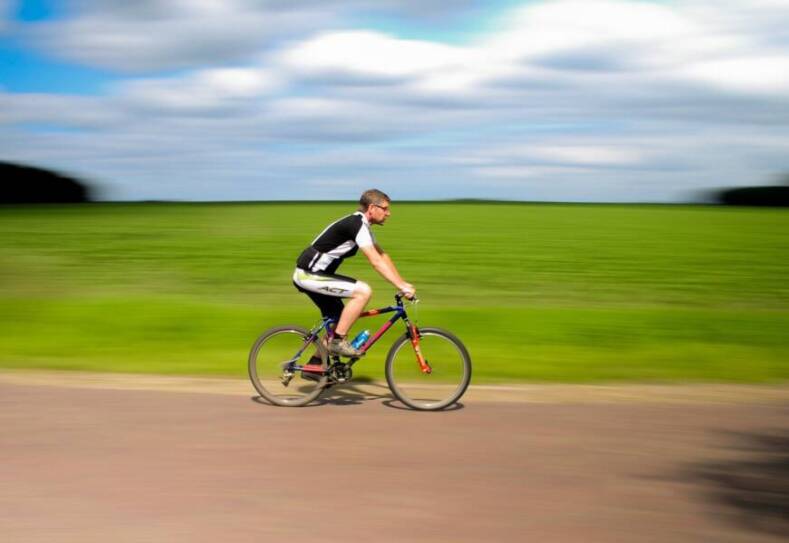Cycling stands out as an efficient way to burn calories, improve cardiovascular health, and enhance overall physical condition. The calories burned per hour while cycling can vary widely depending on several factors including a cyclist’s weight, the cycling speed, and the intensity of the ride. A lighter individual may burn fewer calories than someone who weighs more, as the latter expends more energy to propel themselves and their bicycle. Similarly, the speed and effort exerted during cycling impact calorie expenditure; leisurely biking burns fewer calories compared to vigorous cycling.
The health benefits of cycling are multifaceted. It’s not just about calorie burn; consistent cycling can boost heart health, increase muscle strength and flexibility, improve joint mobility, and decrease stress levels. When discussing calories burned, it’s important to recognize that these numbers offer more than just measures of energy expenditure. They also reflect the intensity of the workout and, consequently, the extent of the health benefits one might expect to gain from cycling.
The effectiveness of cycling as a means to burn calories is supported by various calculators and formulas that estimate energy expenditure based on specific inputs. Accurate estimation requires a consideration of personal attributes like weight and an understanding of the type of cycling activity, whether it’s a casual ride in the park or a rigorous mountain biking session. Findings suggest that when cycling at a steady pace, a person weighing around 150 pounds might burn approximately 48 to 75 calories per mile, depending on their speed. These estimations are crucial for those who target weight loss or fitness through cycling, allowing them to tailor their workouts to meet personal goals.
Understanding Calories and Energy Expenditure
This section comprehensively addresses how calories function as a measure of energy and the role of metabolism in energy expenditure during cycling.
Basics of Calories and Energy
Calories are the units of energy that measure the fuel the body needs and uses. When cycling, a person uses this energy to propel themselves, and this usage translates into calorie burn. The Metabolic Equivalent of Task (MET) serves as a guide to estimate the energy expenditure for various activities. Cycling, depending on the intensity and an individual’s weight, can burn a significant number of calories per hour.
- Light cycling estimates a burner of approximately 300 calories per hour.
- Moderate cycling increases that expenditure, with an average of around 600 calories per hour.
- Vigorous cycling can further elevate the burn to roughly 1,000 calories per hour.
It is vital to note that these values are estimated averages and actual calorie burn will vary depending on several factors including a person’s individual metabolic rate, the speed of cycling, and the terrain type.
Metabolism and Basal Metabolic Rate
The basal metabolic rate (BMR) describes the number of calories a person’s body needs at rest to maintain vital functions, like breathing and keeping warm. Metabolism encompasses all biochemical processes that occur within the body, including converting and using energy from food.
- An individual’s BMR is influenced by various factors such as age, gender, weight, and muscle mass.
- An understanding of one’s BMR can help in better estimating total calorie expenditure during cycling.
- Typically, activities have assigned MET values where a MET of 1 equates to the energy expenditure at rest – roughly correlating to a person’s BMR.
Cycling’s energy demands go significantly beyond the BMR, impacting overall metabolism and requiring both immediate energy and energy derived from stored resources, leading to calorie consumption for immediate use and, over time, potential weight changes.
Factors Influencing Caloric Burn in Cycling
The calories an individual burns while cycling are impacted by multiple interrelated factors such as their body weight and the environmental and physical conditions of their ride.
Weight and Resistance
The body weight of a cyclist plays a crucial role in determining caloric expenditure. Heavier individuals typically burn more calories per hour due to the greater effort required to propel themselves. Resistance—both internal, such as body fat percentage, and external, like wind resistance or the drag of the bicycle itself—further influences calorie burn.
- 55kg cyclist: Estimated 440 kcal/hour at 13mph/21kph
- 90kg cyclist: Higher expenditure due to increased resistance
Age and Fitness Level
A cyclist’s age and fitness level significantly affect their metabolic rate and thus caloric burn. Younger riders and those with higher fitness levels often have a higher metabolism, leading to increased calorie expenditure. However, as one ages or if their fitness level declines, the metabolic rate can decrease.
- Fitness: Trained muscles burn calories more efficiently
- Higher metabolism: More calories burned at rest and during cycling
Cycling Intensity and Duration
Intensity and duration of cycling are directly proportional to caloric burn. The faster and longer a cyclist rides, the more calories they will burn. A leisurely pace results in lower expenditure, while vigorous cycling significantly increases caloric burn.
- Example: Cycling at 10mph for 1 hour
- 150 pound person: Approximately 487 calories
- 200 pound person: Approximately 649 calories
Terrain and Conditions
Terrain and conditions under which cycling occurs affect calorie consumption. Riding on flat, smooth surfaces requires less energy than cycling on hilly or rough terrain. Environmental factors such as heat, cold, or wind also play a role in energy expenditure.
- Flat terrain: Lower calorie burn compared to hilly terrain
- Adverse conditions: Increased energy demand and higher calorie burn
Measuring Caloric Burn
When tracking the caloric expenditure during cycling, there are reliable tools at one’s disposal. Each of these tools approaches the measurement of energy burned from a different perspective but aims to provide the most accurate estimate possible.
Use of Calorie Calculators
Calorie calculators are tools designed to estimate the number of calories burned biking. They usually consider variables such as a person’s weight, the cycling duration, speed, distance covered, and the terrain type. For instance, a 200-pound individual biking at a moderate pace of 10 mph on level terrain is estimated to burn approximately 649 calories per hour. The functionality of these calculators ranges from simple online forms to advanced features within fitness-tracking apps.
Role of Power Meters
Power meters, in contrast, measure the work a cyclist performs in real-time. They provide a direct measurement in kilojoules (kJ), which can be converted to calories (1 kJ is approximately equal to 0.24 kcal). This tool is often regarded as highly accurate because it captures the cyclist’s effort regardless of external factors like terrain. To utilize this metric, cyclists need to know that the caloric equivalent of the energy expended in kilojoules is a crucial number for measuring calorie burn. This allows for an individualized and precise measurement of energy expenditure during rides.
Cycling for Weight Loss and Health
Cycling is an effective way to burn calories and promote weight loss while also offering a range of health benefits. A person engaging in cycling can expect not only a reduction in weight but also enhancements in cardiovascular health, muscle strength, and overall wellness.
Strategies for Effective Weight Loss
Calories Burned Cycling: One’s weight and cycling pace significantly affect the number of calories burned. For instance, a person weighing 185 pounds may burn approximately 355 calories cycling at a moderate pace for 30 minutes. Upping the pace can result in even higher calorie expenditure. A systematic approach to cycling can lead to consistent weight loss, provided it is accompanied by a balanced diet and a calorie deficit.
- Create a Calorie Deficit: An individual needs to burn more calories than they consume to lose weight effectively. A conservative 15-20% reduction in daily calorie intake can complement the calories burned during cycling and lead to fat loss.
- Regular Cycling Schedule: Consistency is key. Integrating cycling into one’s weekly routine can ensure a steady burn of calories.
Health Advantages of Cycling
Cycling is not only beneficial for weight loss but is also advantageous for one’s overall health.
- Cardiovascular Health: Regular cycling increases heart rate, promoting a healthy cardiovascular system.
- Muscle Strength: It strengthens the leg muscles and contributes to overall muscle fitness without overstraining them.
- Low Impact: Cycling is a low-impact exercise, meaning it is easier on the joints compared to high-impact exercises like running.
- Mental Health Benefits: It can reduce stress levels and improve mental health through the release of endorphins, the body’s feel-good chemicals.
Given the calorie burning potential and the broad health benefits, cycling can be a highly beneficial component of an individual’s health and weight loss regimen.
Nutrition and Diet for Cyclists
Cyclists require a tailored nutritional approach to maintain energy levels and optimize performance. Understanding the balance and timing of nutrient intake is crucial for both training and racing.
Fuel for Cycling
For effective fueling, cyclists need to consume carbohydrates strategically during rides. The body’s ability to utilize carbohydrates as a fuel source is measured in grams per hour.
- Short Rides (1-2 hours): Approximately 30 grams of carbs per hour.
- Medium Rides (2-3 hours): Around 60 grams of carbs per hour is recommended.
- Long Rides (3+ hours): Intake should be increased to about 90 grams of carbs per hour.
These figures can vary based on individual cyclist’s metabolism, the intensity of the ride, and tolerance to carbohydrate-rich foods. Easy-to-digest items such as energy gels, bars, and sports drinks can help maintain glucose levels and energy.
Dietary Considerations
Cyclists’ diets should consist of a balanced mix of carbohydrates, proteins, and fats, ensuring that the body is well-nourished for both recovery and exertion. A diet rich in fruits can provide natural sugars and fiber, aiding in energy production and digestion.
Carbohydrates: The primary source of energy for cyclists, especially during high-intensity rides. It is important to include a variety of carbohydrate sources for steady energy release.
Fruits and Natural Foods:
- Bananas: High in potassium, contributing to muscle function.
- Berries: Antioxidants can help with recovery.
- Apples: Fiber-rich for sustained energy release.
Proteins and Fats: Though less immediate as a fuel source during a ride, they are essential for overall health and muscle repair. Including a variety of fats, particularly omega-3 fatty acids, supports long-term cardiovascular health.
Training and Performance
When cyclists focus on training and performance, they specifically aim to enhance their fitness and prepare for races by optimizing power output and maintaining an appropriate caloric intake to sustain their average power.
Building Fitness
Training for cycling involves structured workouts aimed at increasing cardiovascular fitness and muscular endurance. One measurable factor of a cyclist’s training is their average power output, which is the average amount of power in watts that they can sustain over a given period. A strategically planned training regimen will increase this average power output incrementally. Cyclists often use power meters to track and optimize their workouts, ensuring that they are training at the right intensity to build fitness.
- Key Factors in Building Fitness:
- Consistency: Regular and progressive training sessions contribute to continuous fitness improvements.
- Intensity: Incorporating various intensities, from steady endurance rides to high-intensity interval training (HIIT), helps enhance overall performance.
- Rest: Adequate rest and recovery are crucial as they allow the body to adapt and strengthen after rigorous workouts.
Preparation for Races
Preparing for races requires a balanced approach to nutrition and a tactical increase in training intensity. The days leading to a race are vital for carbohydrate loading to ensure that glycogen stores are maximized. Cyclists consume about 90 grams of carbohydrates per hour for races lasting more than three hours to optimize endurance and performance. Power output becomes a primary focus during a race, with efforts made to match the demands of the racecourse—whether that includes steep climbs, sprints, or sustained high-speed sections.
- Race Preparation Checklist:
- Tapering: Reducing training load before the race to arrive well-rested and primed.
- Nutrition Strategy: Planning a nutrition schedule for race day, including hydration and carbohydrate intake.
- Power Strategy: Tailoring the race strategy to the cyclist’s strengths in power output and endurance.
Training and performance in cycling are deeply intertwined, with properly managed training leading to noticeable improvements during race day. The caloric output, closely related to average power, should match the cyclist’s dietary intake to fuel their riding efforts effectively.
Comparing Cycling to Other Activities
When it comes to calorie burn and cardiovascular benefits, cycling is often compared to other forms of exercise, particularly running and stationary cycling.
Cycling vs. Running
Cycling and running are both effective cardiovascular activities that have nuanced differences in the intensity and impact they have on the body. An individual’s heart rate serves as a reliable indicator of their exertion level during both activities. Running tends to burn more calories per mile compared to cycling since it requires the body to support its own weight, which intensifies the workout.
| Activity | Caloric Burn (Approx.) |
|---|---|
| Running (6mph) | 566-839 calories/hour |
| Cycling (12-13.9mph) | 472-745 calories/hour |
However, cycling is typically lower impact, making it a suitable option for individuals looking to avoid the joint stress that can accompany running.
Stationary Bike vs. Road Cycling
A stationary bike offers a consistent workout environment, and some may find it easier to maintain a constant heart rate due to the lack of varying terrain. Conversely, riding a bike outdoors can be more dynamic with changes in terrain and wind resistance affecting the calorie burn.
| Activity | Caloric Burn (Approx.) |
|---|---|
| Stationary Biking | 400-600 calories/hour |
| Road Cycling | 500-1000 calories/hour |
Variables such as the rider’s body weight, biking intensity, and duration remain crucial determinants of energy expenditure for both stationary and road cycling. However, the figures for road cycling can vary significantly due to environmental factors and changes in speed.
Cycling Resources and Community
Cycling enthusiasts often seek reliable sources of information to enhance their riding experience and equipment knowledge. Resources offering reviews and expert buying guides are invaluable for making informed decisions. Connecting with other cyclists provides a sense of community and opportunities to share race content and experiences.
Expert Buying Guides and Reviews
Buyers and enthusiasts turn to expert buying guides and reviews to navigate the vast market of cycling gear. These resources often include:
- Leadout Newsletter: A publication renowned for keeping cyclists informed with the latest gear reviews and cycling news.
- Features: In-depth articles that explore new cycling trends and technologies.
- Reviews: Critical assessments of products that give insights into performance and value.
Experts leverage their industry knowledge to tailor buying guides that match the needs of cyclists at all levels, from beginners to seasoned pros.
Connecting with Cyclists
The cycling community is vibrant and engaging, offering various platforms where individuals can connect:
- Cyclist Interviews: These provide personal stories and professional tips, directly from experienced riders.
- Race Content: Sharing race experiences, strategies, and results helps cyclists learn from each other.
- Online Forums and Social Groups: Platforms where cyclists can share routes, organize meetups, and discuss all things cycling.
Connecting with fellow cyclists opens up a network for support, learning, and camaraderie, fostering a sense of belonging within the cycling community.








